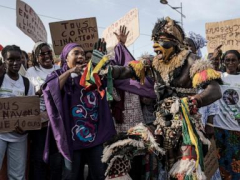NIOKOLO-KOBA NATIONAL PARK, Senegal — The morning sun slants through the canopy of Senegal’s Niokolo-Koba National Park as Sgt. Abdou Diouf and his brigade of rangers march in single file, guns at the ready. They scan the brush for signs of poachers, but today, it seems, the only hunters are the lions themselves, their fresh tracks pressed into the sand.
As the sun climbs, a guttural call reverberates across the forest. The rangers pause. “Lions,” Diouf says.
Spanning more than 3,500 square miles – double the size of Rhode Island – Niokolo-Koba is the last sanctuary in Senegal for lions, which are critically endangered in West Africa. But even here, they find little respite. Driven by deeply rooted beliefs in the mystical powers of animal skin talismans known as “gris-gris,” the illegal trade of lion and leopard parts is growing, according to a new report by wild cat conservation group Panthera.
Panthera’s investigation found lion and leopard parts sold in 80% of markets surveyed, with 63% of artisans reporting increased sales in recent years. For Niokolo-Koba’s lions, the impact has been devastating. Despite enhanced protections that doubled the population to around 35 since 2017, helping delist the park as a UNESCO World Heritage Site in danger, an unsustainable average of two cats are still lost to poachers each year.
The only other place lions are found in West Africa is in the W-Arly-Pendjari Complex, a border region of Benin, Burkina Faso and Niger, and Panthera estimates there are fewer than 250 adults left in the region.
The gris-gris, prescribed by influential religious leaders called marabouts, are crafted from bits of skin with written prayers or Quranic verses sewn inside. They are widely used across Senegal; police don them for protection, wrestlers for strength, politicians for clout. Average citizens wear them to ward off curses that other people may have put on them for a variety of reasons — matters of romance, perhaps, or jealousy at economic success.
Gris-gris are rooted in traditional African faiths that believe vital powers in animals and nature may be unlocked — to harm, to heal, or to protect, said Dr. Cheikh Babou, a history professor and expert in West African Islam at the University of Pennsylvania.
With Islam’s arrival in West Africa in the eighth century, gris-gris became hybrid objects, melding Quranic verses with the perceived powers of animal parts. “People started to drink the Quran, to wear the Quran – in the same way that they did with animals,” Babou said.
At a market stall in Tambacounda, Ibrahim, a customer who asked that his last name be withheld because the trade of lion parts is illegal, wears several amulets around his waist. Made from hyena, honey badger, goat, fox, jackal, monkey, and lion, each serves a specific purpose. He began wearing them years ago after falling ill; someone had cast a spell on him, he s





